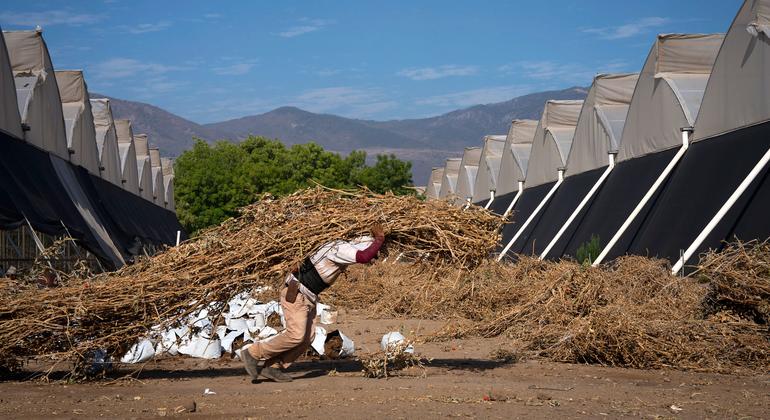More than 70 percent of the global workforce works in extreme heat conditions |

Balint Nafradi: Heat is a well-known occupational safety and health risk factor. We’ve known about it since the 1950s, but if you opened an occupational safety and health textbook written at that time, you would see that it could be dangerous for bakers or workers in metal foundries – those are the specialist occupations. And our report found that the scope of the problem is much larger than that. About 2.4 billion workers, or 71 percent of the global workforce, are exposed to extreme heat on the job. And over the past 20 years, the rate of exposure has increased by almost nine percent. We identified 22.8 million occupational injuries due to extreme heat, nearly 19,000 deaths and more than 26 million cases of kidney disease as a result of long-term exposure to high temperatures on the job.
UN News: What are the new occupations and what new threats have emerged compared to estimates 50 or 70 years ago?
The realisation is that this really affects a large part of the workforce. It’s not just the few specialized occupations that have artificial heat sources. It’s not just agriculture or construction, it’s people who work indoors, especially in poorly ventilated workplaces – they’re all exposed to heat. And then, because they’re working, they tend to be exposed for longer periods of time. They can’t avoid it.
I think the main understanding or perception is that this is really a global problem both in terms of geography and distribution of the workforce.
UN News: Your report covers all regions. Do you see differences in responses to hazards based on the fact that in some regions, heat is something that has been around for a long time, but in other regions, it might be something new, coming with this climate change?
Balint Nafradi: A large part of the heat exposure of workers comes from the sun. And obviously in warmer regions or countries, this problem already exists. So 70 percent of the workforce is exposed, which is the global average. In regions like Africa, it’s over 90 percent, and in the Arab countries, it’s over 80 percent. Of course, there are variations, because in Europe, especially in the northern parts of Europe, it’s less than 30 percent. So there’s this geographical variation.
Regions that tend to be colder, like Europe, have shown much faster growth than the average over the past 10 years. So in terms of response, that creates two different challenges.
For areas that are currently experiencing significant, high exposures, the challenge is to mitigate this occupational health and safety hazard. For areas that are relatively low exposures but are increasing rapidly, the challenge is to adapt to this new changing work environment. It makes a difference if it is 25, 35 or 45 degrees Celsius. Which brings us to the topic of heat waves and their discussion. The rate or magnitude of heat waves is increasing most rapidly in the Americas. But the report still shows that nine out of 10 workers who are exposed, they are exposed outside of heat waves. Heat waves, if you like, are just the tip of the iceberg that helps to see the problem, but the majority of workers are actually exposed at times when there is no official warning.
UN News: In this situation, what policies are in place? What is the response to this new and growing challenge?
Balint Nafradi: There are specific guidelines regarding heat exposure. International Labor Organization has compiled a Code of Practice for the Workplace, which includes a chapter on protecting workers from heat exposure. There are specific international labour standards. They provide guidance on protecting certain groups of workers.
We found that most countries have some kind of labor laws, but most are outdated and not built to account for the large proportion of the workforce that is affected by this.
We also identified a number of cases globally where labour laws have been updated recently: for example, temperature limits are set depending on the activity. Often, it is not just temperature that is important, but other factors such as humidity or air movement that are included in many of these updated laws. In most places, acclimatisation or hydration, work intensity requirements or adaptation of work intensity to temperature are included in the laws. Those are positive signs that we found. But many of these laws are primarily in response to the heat waves that I mentioned earlier. That is only one in 10 workers, that is one in 10 exposures. The other nine factors still need to be considered and workers need to be protected.
The important part is to update the labour laws, but in this process, social dialogue is really important. Active participation of both workers and employers, because they are the first to know what risks are there and how best to deal with them. We have 21 countries in our report from around the world, from Europe, Japan and China, Mexico and South Africa – really a lot of countries. The local realities there are different. Many of the updated laws have specific guidance on work intensity. There are different rules that apply if it is heavy physical activity or if it is office work, etc.
It is also recommended that work arrangements be adjusted to the temperature. It is not necessary to change the hours of work, as we know that shift work or night work is inherently particularly hazardous. We do not want to be in a situation where we have to replace one hazard with another. But there are many practices that can be implemented: such as heavy lifting, doing heavy physical work during the cooler hours and other activities during the warmer hours. Another recommended practice is to provide shade or areas where workers can get out of the heat or escape from the heat. Providing water and drinking water is a really important safety measure.
Education and awareness for both workers and employers is important so that they know that heat is a hazard. And of course that is especially important in areas where heat is rising rapidly. We would assume that in Africa, everyone knows that heat is a problem. But in Northern Europe, one of the fastest growing areas, people need to get used to the idea that if there is a hot week coming up, which was great weather 20 years ago, today it is a week of temperatures above 35 degrees Celsius. And that is a temperature that can be dangerous on the job.
UN News: The Olympics are starting in Paris and the athletes are workers, right? As are the thousands of people who will serve the Games, making this major sporting event a huge success. Do you have any tips to share on how to stay fit without any negative health consequences from the hot weather?
Balint Nafradi: Maybe I should start with a fun fact: one of the first studies, back in the 1950s, that looked at the effects of heat on human performance was done on professional athletes. So we know for a fact that athletes, just because they are in good physical condition, are not immune to heat. So they have to be careful.
For the rest of us, the usual outdoor activities and advice that applies is to stay hydrated. Stay in the shade as much as possible and don’t be in direct sunlight unless absolutely necessary. Minimize those hours as much as possible. And the third recommendation is to avoid strenuous physical activity. But I guess for the Olympics that’s not really useful advice. It’s hot and if you see someone in the crowd or a colleague, a friend, whoever, feeling dizzy, be careful and call the helpline.


